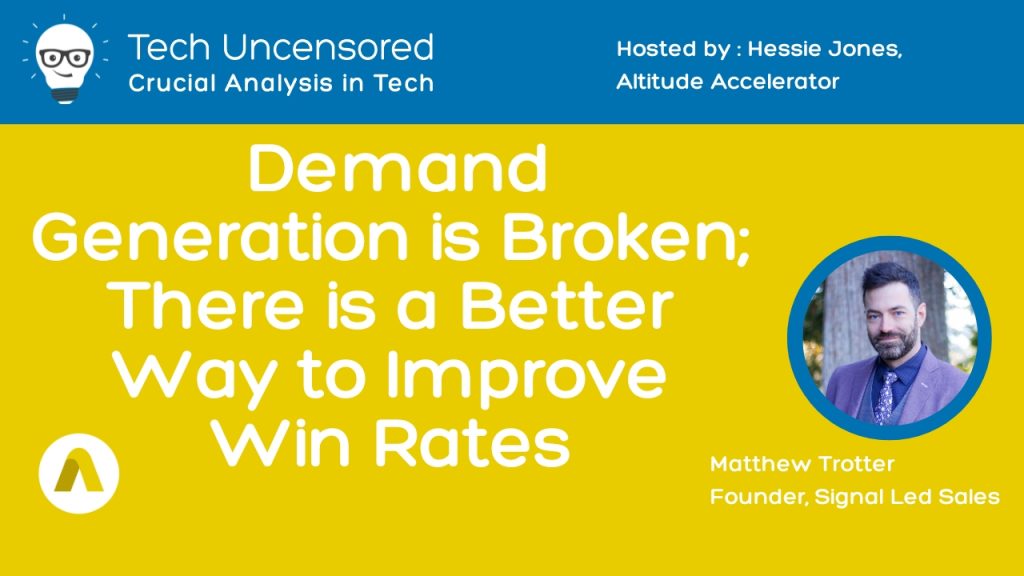by Chhata Gupta
Within a continuously evolving digital landscape, traditional demand-generation strategies are losing their effectiveness. We spoke with Matthew Trotter, a high-performance Sales Coach and is the co-founder of Signal Led Sales, a groundbreaking sales framework aimed to help GTM teams address selling challenges within the digital buyer journey. With over 25 years in the field, specializing in data, AI, and cloud solutions, Trotter reveals how sales and marketing need to adapt to the modern buyer’s journey.
Once a vital principle in sales and marketing teams, demand generation tactics are now encountering significant challenges. It’s clear that a paradigm shift is underway; moving from a broad, awareness-focused approach to a nuanced, intent-based strategy, fundamentally altering how companies engage with potential customers.
Historical Context of Demand Generation
Demand generation has traditionally been about creating a wide net to capture as many leads as possible. From billboards and direct mail to digital ads and SEO, the goal was to generate awareness and interest, progressively nurturing leads down the sales funnel. However, these methods have become less effective with the advent of digital technologies and a more independent and self-determinant buyer’s journey. Buyers now conduct their research, compare solutions, and make purchasing decisions often before interacting with a sales representative.
“The landscape of demand generation has transformed and requires a shift towards strategies that align with the informed, autonomous nature of modern buyers” Trotter observed. His career spans a transformative period in sales and marketing, witnessing firsthand the shift from traditional, broad-based demand generation to the nuanced, intent-focused strategies of today. He recalls how, historically marketing efforts were broad and unfocused, aiming to reach as many people as possible without considering their actual interest or readiness to buy. This scattergun approach often resulted in low conversion rates and inefficient use of resources. As digital platforms proliferated and buyers became more self-directed in their research and purchasing decisions, their inefficiency has become increasingly apparent.
Overcoming Traditional Tactics
Trotter criticizes the old model of demand generation as “broken,” noting that it fails to account for the digital-first journey of modern buyers. He points out that “80% of buyers are going through this journey”, independently of direct sales efforts. This insight challenges the traditional sales funnel, where marketing generates leads for sales to close. Many potential customers are often well-advanced in their decision-making process before they are identified by the sales teams.
The buyer’s journey has transformed, with a significant portion occurring in digital spaces, independent of direct sales influence. This change needs a revaluation of traditional sales and marketing roles and their strategies to capture and engage potential customers effectively.
Intent-Based Selling Explained
As a response to these changes, Trotter emphasizes the need for a more targeted and intelligent approach to demand generation. “Why aren’t we just focusing on the fraction of customers within our account books who have intent to buy right? I think about conserving my time to focus on customers who have the higher propensities to purchase”, he stated, highlighting the transition to intent-based selling. The focus has shifted from trying to capture as many leads as possible to identifying and engaging with those who have shown clear intent to purchase. This new model of demand generation, intent-based selling, prioritizes understanding the buyer’s journey and strategically positioning the company to meet potential customers at the right time with the right message.
He describes how sales teams can leverage various types of intent data—zero-party, first-party, and third party—to identify and prioritize leads who show a genuine interest in making a purchase. Zero-party data includes information that customers voluntarily provide, often indicating direct interest in products or services. First-party data are derived from interactions with a company’s digital properties, like website visits or product trials, revealing interest and engagement levels. Third-party data, sourced from external platforms, offer insights into a potential customer’s broader online behaviour and interests, such as content downloads, event attendance, or industry engagement.
Intent-based selling represents a strategic evolution in demand generation. This approach leverages data and analytics to understand and predict when a potential customer is ready to buy, focusing on the quality of leads rather than quantity. By analysing behavioural signals across various channels, companies can discern the intent behind actions, enabling them to target their outreach more effectively thus allowing sales professionals to engage with prospects more meaningfully, increasing the efficiency and effectiveness of their efforts.
Analysing Buyer Intent
Adopting an intent-based approach requires sales and marketing teams to integrate and analyse these data types, transforming raw information into actionable insights. “The magic word that came to light was this idea of intent,” Trotter mentioned, highlighting the shift in strategy. This integration helps in forming a comprehensive understanding of the buyer’s journey, identifying the most promising leads based on demonstrated interest and engagement.
Trotter discusses how the application of intent-based selling strategies involves a deep understanding of the buyer’s journey and the alignment of sales efforts with the prospect’s readiness to engage. He stresses the importance of sales teams becoming more like intent analysts, who can decipher the digital signals of potential customers and craft personalized engagement strategies.
Businesses need to develop a systematic process for interpreting intent signals, aligning sales efforts with customer readiness, and tailoring communications to meet the nuanced needs of each prospect. By focusing on intent-rich leads, companies can allocate their resources more efficiently, engaging with potential customers at the optimum point in their purchasing journey.
The Future of Marketing
The future of demand generation will increasingly rely on our ability to leverage data intelligently and harness the power of intent data to make more informed, strategic decisions about where to focus sales and marketing efforts, Trotter concluded. Emphasizing the importance of adapting to buyer intent, as we look ahead, the integration of advanced analytics, AI, and machine learning will further refine the process, enabling even more precise targeting and personalized engagement.
Trotter offered a compelling view of the future of demand generation, where success hinges on the ability to understand and dynamically engage upon buyer intent.
The journey from traditional demand generation `to intent-based selling is a necessary evolution in response to the increasing context that data provides. Evolving with this change will ensure companies will thrive as the speed of information will only hasten.

Missed our podcast? Catch it here!
Looking to transform your startup into a market leader and establish a dynamic personal brand? Altitude Accelerator offers unparalleled support to tech entrepreneurs through our extensive network of expert mentors and seasoned investors. Altitude Accelerator has partnered with BHive to support Cleantech founders through the Startup VISA Program to help them grow and commercialize their businesses. Fuel your cleantech growth today!

